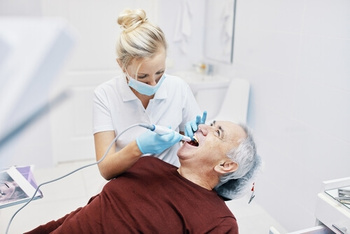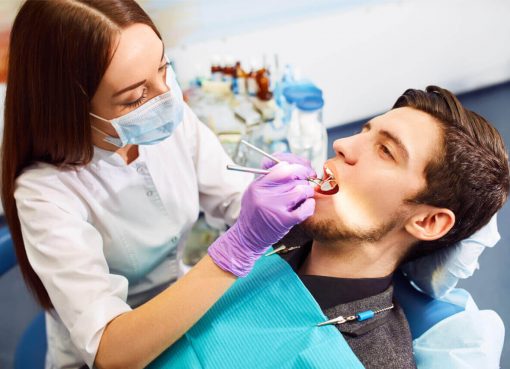A dental implant can be a life-changing solution for missing teeth, restoring function, confidence, and your smile. But just like natural teeth, implants require care to remain healthy. One condition that can threaten your implant is peri-implantitis, a form of gum disease that causes inflammation and, over time, jawbone loss around the implant.
If you’re wondering how to treat peri-implantitis at home, especially in its early stages, there are steps you can take to support healing and protect your implant. This guide offers clear, practical advice for managing symptoms at home, while explaining when it’s time to call a dental professional.
What Is Peri-Implantitis?
Peri-implantitis is an inflammatory disease affecting the soft and hard tissues around the implant. It begins as peri-implant mucositis, a reversible condition that involves inflammation without jawbone loss. If left untreated, it can develop into peri-implantitis, where the infection causes bone loss and threatens the implant’s stability.
Common peri-implantitis symptoms include:
- Red, swollen, or bleeding gums near the dental implant
- A bad taste or odor coming from the infected area
- Gum recession that is exposing more of the implant surface
- Tenderness, pain, or sensitivity around the implant
- In advanced cases, the mobility of the implant due to bone loss
This condition shares similarities with gum disease and is often caused by poor oral hygiene, plaque buildup, smoking, or systemic health issues like diabetes.
Can You Treat Peri-Implantitis at Home?
That said, home care plays a crucial role in slowing progression and supporting your overall dental health. Let’s explore the steps you can take.
Practice Good Oral Hygiene Daily
Maintaining good oral hygiene is your first defense. Bacteria that cause peri-implantitis build up quickly if the implant site isn’t cleaned properly.
- Brush your teeth twice daily using a soft-bristled brush and gentle, non-abrasive toothpaste.
- Switch to an electric toothbrush for more effective cleaning of the implant.
- Use interdental brushes or implant-specific floss to reach between teeth and underneath the prosthetic crown.
- Add a water flosser to help flush bacteria from the implant and under the gums.
This consistent routine supports healthy gums and reduces the risk of a dental implant infection.
Rinse with Antimicrobial Solutions
Antibacterial mouth rinses can help reduce harmful bacteria near the infected dental implant. Chlorhexidine is a common rinse for this purpose, but it should be used under a dentist’s supervision to avoid side effects like staining.
A warm salt water rinse (half a teaspoon of salt in a cup of warm water) is a gentler option for daily use. It can soothe gum inflammation and help keep the area clean.
Avoid Irritants That Delay Healing
 If you’re trying to treat peri-implantitis, it’s important to stay away from habits and substances that can worsen the condition.
If you’re trying to treat peri-implantitis, it’s important to stay away from habits and substances that can worsen the condition.
- Avoid smoking, which restricts blood flow and impairs healing around the implant.
- Reduce alcohol consumption, which can contribute to dry mouth and irritation.
- Steer clear of hard, crunchy, or sticky foods that may stress the implant site.
Opt for soft, nutritious meals that support gum healing and avoid putting excess pressure on the implant surface.
Apply Warm Compresses for Comfort
Apply a warm compress to the outside of your cheek for minor discomfort. It can help reduce swelling and ease soreness. Pair this with saltwater rinses to clean and calm the tissue around the implant.
These measures can provide short-term relief but should never replace professional care if your symptoms worsen.
Use Oral Probiotics to Support Gum Health
Some oral probiotics have been shown to support good bacteria in the mouth, which may reduce inflammation and help control harmful microbes surrounding the implant. Look for probiotics with strains like Lactobacillus reuteri or Streptococcus salivarius.
These supplements may offer added support when used alongside proper brushing and flossing, not as a replacement.
Invest in the Right Cleaning Tools
Using tools designed specifically for dental implants makes a noticeable difference when treating peri-implantitis.
- Implant-specific floss, like Super Floss, can help clean under fixed prosthetics.
- Interdental brushes can reach narrow spaces surrounding the implant.
- Water flossers allow you to clean below the gumline where bacteria can hide gently.
- Rubber-tipped stimulators can massage the gums and dislodge debris.
These tools make it easier to maintain a healthy environment around the implant and prevent future implant failure.
Monitor Your Symptoms Closely
When managing peri-implantitis at home, keep a close eye on your progress. If the condition is mild, you should see a gradual reduction in bleeding, inflammation, and discomfort within a couple of weeks.
Signs of improvement include:
- Less redness and swelling
- No bleeding when brushing or flossing
- No lingering pain or tenderness
- Better breath and taste in your mouth
However, if you notice signs of infection—like persistent bleeding, pus, pain, or a loose implant—it’s time to contact your dental professional. Advanced peri-implantitis can cause irreversible bone loss if left untreated.
Keep Up with Your Dental Appointments
 Even when treating peri-implantitis, professional care is essential for long-term success. Your dentist will examine the tissues around the implant, assess for signs of jawbone loss, and clean areas you can’t reach at home.
Even when treating peri-implantitis, professional care is essential for long-term success. Your dentist will examine the tissues around the implant, assess for signs of jawbone loss, and clean areas you can’t reach at home.
Dental professionals may use special tools to remove deep plaque or recommend surgical treatment in more severe cases. Regular dental checkups also allow early detection of peri-implantitis before it becomes more serious.
The Risks of Ignoring Peri-Implantitis
When left untreated, peri-implantitis can lead to jawbone loss, infection, and eventually implant failure. Because the condition is often painless in its early stages, many people don’t realize they have a problem until it’s too late.
Taking action early at home and with your dentist can protect your investment and prevent further complications.
Final Thoughts: Work With Your Dentist, Start at Home
Learning how to treat peri-implantitis is about more than just brushing your teeth. It involves improving your overall oral hygiene habits, staying aware of your symptoms, and using the right tools to clean around the implant thoroughly.
But remember—peri-implantitis is a serious condition. Home care can help manage early symptoms and keep your gums healthy, but it cannot replace the expertise of dental professionals. If you have a dental implant and notice any signs of infection or inflammation, don’t wait. Seek help to preserve your oral health and your smile.
References
https://gumdiseaseguide.org/dental-implant-infections/
https://curaprox.us/blog/post/peri-implantitis-what-to-do-about-inflammation-around-an-implant-?srsltid=AfmBOorgce6r7wXIiOxkbtklXG3YUyNo-C9FQnpWXrGxv17z5marNoxR
https://pmc.ncbi.nlm.nih.gov/articles/PMC3612185/
https://www.dentalcare.com/en-us/ce-courses/ce680/non-surgical-treatment






Comment here